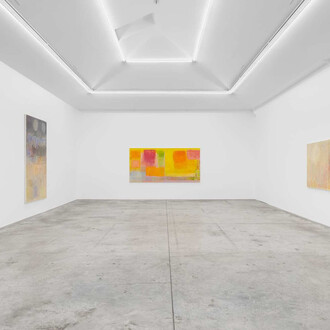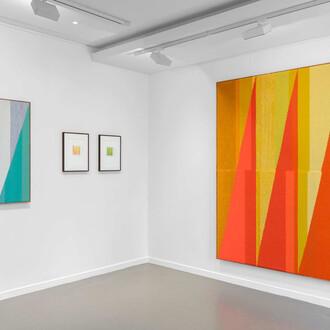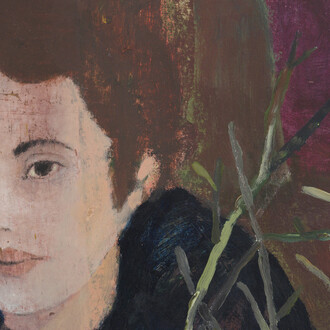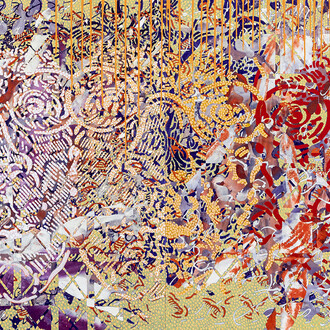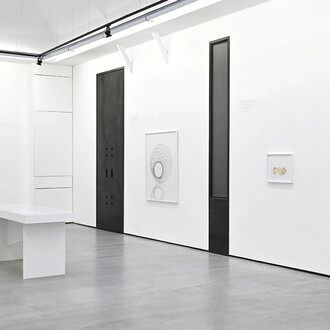Almine Rech Paris is pleased to announce the first exhibition by Kenneth Noland with the gallery organized in collaboration with the Paige Rense Noland 2008 Marital Trust and The Kenneth Noland Foundation. Rarely shown in Paris, and in France, this selection of works constitutes an important survey exhibition, featuring paintings realized between 1960 and 2006.
Kenneth Noland ranks among the most recognized artists of the Color Field and Post Painterly Abstraction. Well-known for his colored concentric circles, chevrons and stripes, he is considered as “one of the great colorists of the 20th century” by Karen Wilkin, the author of a monograph on Noland. “His art was from start to finish an art of color, part of a long tradition that dates in the modern era to Impressionism, runs through Cézanne and Matisse, into the twentieth century, to Morris Louis, and Helen Frankenthaler.” writes the author. “To the end, Noland added to that tradition by exploring ways of color painting virtually unimaginable, and often without precedent. As he worked into the twenty- first century, his art took on more and more color and therefore more light. This was a new direction for Noland, making the trajectory of his art all the deeper and wider. His light will surely remind us of the golden hues of the American Luminist painters of the nineteenth century.”
Noland spent years exploring the implications of the stripes inventing seemingly endless variations, from complex orchestrations of multiple stripes to empty centers with concentrated groupings at top and bottom. In the 70s, he adds a new movement in his work, giving more space for more color experimentation. For works such as Interlock Color (1973), and others from the plaids series, vertical fields are dissected by slender grids and the places where bars overlap are emphasized by changes in color and density. The plaids while predominantly vertical, also included several square diamonds. In some of his shaped canvases of this period, Noland at once emphasized and distorted the edges of his shapes by means of color changes and groupings of color bands. From the end of the 70s, and over the next few years, the shapes ranged from relatively regular near-rectangles, slightly irregular, to unconventional irregular hexagons and unamenable, culminating in the slender figures sometimes referred to as surfboards from 1981-82 (such as Begin and End, 1981). With the chevrons of the 1980s, surfaces are newly opulent, there is a new emphasis on layering and transparency, a true mutability of color. As in Comet (1983), Noland transforms the chevrons into what are essentially brand new works and interjects a veritable primer on new varieties of color application. In the paintings of the last years, such as Into the Cool No.9 (2006) and Burst (2006) “he combined all he had discovered over the course of this latest series, a perfect pitch, a fusion of emphatic color at right center to barely discernible at left and center bottom; an in and out weaving of pinks and blues; quasi geometric shapes with an amorphous bleeding of the hues with a touch of mastery that certifies Noland’s genius. Then, almost as an exit, a single line from the bottom of the circle to the lower edge takes us quietly out of the gentle pictorial turmoil of the painting.” With the strong but quiet paintings of the last years, Noland creates a meditative aura that invites the viewer into a private dialogue with the art, the artist, and world around us.
Kenneth Noland (b. 1924, Asheville, North Carolina; d. 2010, Port Clyde, Maine) studied at Black Mountain College from 1946 to 1948 with Josef Albers and Ilya Bolotowsky. He had his first solo exhibition at Galerie Raymond Creuze in Paris after moving there in 1948 to study for a year with sculptor Ossip Zadkine. He taught at the Institute of Contemporary Art, Washington, D.C. (1949-51), at the Catholic University, Washington, D.C. (1951-60), and at the Washington Workshop Center of the Arts (1952-56). His work was part of the Venice Biennale (1964) and his first retrospective was held at the Guggenheim Museum (1977), which traveled to the Corcoran Gallery of Art, Washington, D.C. and the Toledo Museum of Art, Ohio (1978). Noland has been the subject of solo exhibitions at a range of international institutions, including the Museo de Arte Moderno, Mexico City (1983); Museo de Bellas Artes, Bilbao, Spain (1985); Museum of Fine Arts, Houston (2004); Tate, Liverpool (2006); and Butler Institute of American Art, Youngstown, Ohio (1986 and 2007).





